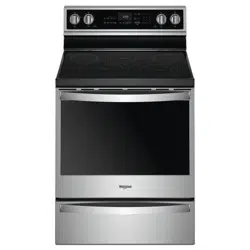Documents: Go to download!
Installation Instruction
- Installation Instruction - (English)
- Warranty - (English)
- installation guide - (English)
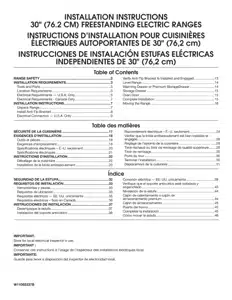
- FEATURE GUIDE
- COOKTOP USE
- OVEN USE
- RANGE CARE
- TROUBLESHOOTING
Table of contents
USER INSTRUCTIONS Electric Range
FEATURE GUIDE
This manual covers several models. Your model may have some or all of the items listed. Refer to this manual or the Frequently Asked Questions (FAQs) section of our website at www.whirlpool.com for more detailed instructions.
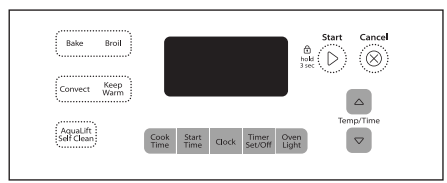
| KEYPAD | FEATURE | INSTRUCTIONS |
| CLOCK | CLOCK |
The Clock uses a 12-hour cycle. 1. Check that the oven is off. 2. Press CLOCK. 3. Press TEMP/TIME “up” or “down” arrow pads to set the time of day. 4. Press SET CLOCK or START |
| OVEN LIGHT | Oven cavity light | The oven light is controlled by a keypad on the oven control panel. While the oven door is closed, press the oven light switch to turn the light on and off. The oven light will come on when the oven door is opened. |
| TIMER (Set/Off) | Oven timer |
The Timer can be set in hours or minutes up to 12 hours and 59 minutes. 1. Press TIMER. 2. Press TEMP/TIME “up” or “down” arrow pads to set the length of time. 3. Press START to begin the countdown. If enabled, end-of-cycle tones will sound at end of countdown. 4. Press TIMER twice to cancel the Timer. Do not press the Cancel keypad because the oven will turn off. 5. If the TIMER is running, but not in the display, press TIMER to display the countdown for 5 seconds. |
| START | Cooking start | The Start pad begins any oven function. If Start is not pressed within 5 seconds, “PUSH” appears in the display. If Start is not pressed within 1 minute after pressing a keypad, the function is canceled and the time of day is displayed. |
| CANCEL | Range function | The Cancel keypad stops any function except the Clock, Timer and Oven Control Lockout. |
| TEMP/TIME | Temperature and time adjust | The “up” or “down” arrow pads are used to adjust time and temperature settings. |
| BAKE | Baking and roasting |
1. Press BAKE. 2. Press TEMP/TIME “up” or “down” arrow pads to set a temperature other than 350°F (175°C) in 5°F (5°C) increments between 170°F and 500°F (75°C and 260°C). 3. Press START. 4. To change the temperature, repeat Step 2. Press START or wait 5 seconds for the change to take effect. 5. Press CANCEL when finished. |
| BROIL | Broiling |
1. Press BROIL. 2. Press TEMP/TIME “up” or “down” arrow pads to change the temperature in 5°F (5°C) increments between 300°F and 500°F (150°C and 260°C). 3. Press START, and allow oven to preheat for 5 minutes. 4. Position cookware in the oven and close the oven door to the broil stop position so that the door is open approximately 6" (15 cm). 5. Press CANCEL when finished. |
| CONVECT | Convection baking and roasting |
1. Press CONVECT. 2. Press TEMP/TIME “up” or “down” arrow pads to set a temperature other than 350°F (175°C) in 5°F (5°C) increments between 170°F and 500°F (75°C and 260°C). 3. Press START. 4. To change the temperature, repeat Step 2. Press START or wait 5 seconds for the change to take effect. 5. Press CANCEL when finished. |
| KEEP WARM | Hold warm |
Food must be at serving temperature before placing it in the warmed oven. 1. Press KEEP WARM. 2. Temperature is set at 170°F (75°C) for 60 minutes (1.00 hour). 3. Press START. 4. Press CANCEL when finished. NOTE: The oven will automatically turn off after 60 minutes. |
| START TIME | Delayed start | The Start Time keypad is used to enter the starting time for an oven function with a delayed start. Start Time should not be used for foods such as breads and cakes because they may not bake properly. To set a Timed Cook or a Delayed Timed Cook, see “Cook Time” section |
| COOK TIME | Timed cooking | Timed Cooking allows the oven to be set to turn on at a certain time of day, cook for a set length of time, and/or shut off automatically. To set a Timed Cook or a Delayed Timed Cook, see “Cook Time” section. |
| AQUALIFT SELF CLEAN | Clean cycle | See the “Clean Cycle” section. |
| START (hold 3 sec to lock) | Oven control lockout |
1. Check that the oven is off. 2. Press and hold the START (hold 3 sec to lock) keypad for 3 seconds. 3. A tone will sound, and “Loc” will be displayed. 4. Repeat to unlock. Only the CLOCK, OVEN LIGHT and TIMER keypads will function with the controls locked. The cooktop functions are not affected by the oven control lockout. |
COOKTOP USE
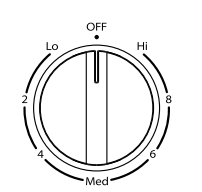
The control knobs can be set to anywhere between HIGH and LOW. Push in and turn to setting.
REMEMBER: When range is in use, the entire cooktop area may become hot.
Ceramic Glass
- The surface cooking area will glow red when an element is on. Some parts of the surface cooking area may not glow red when an element is on. This is normal operation. The burner will cycle on and off to maintain the selected heat level. It will also randomly cycle off and back on again even while in High to keep the cooktop from extreme temperatures.
- It is normal for the surface of light colored ceramic glass to appear to change color when surface cooking areas are hot. As the glass cools, it will return to its original color.
- Clean the cooktop after each use to help avoid scratches, pitting, abrasions and to condition the glass surface. Ceramic glass cooktop cleaner and a cooktop scraper are also recommended for stubborn soils. Do not use abrasive cleaners, cleaning pads or harsh chemicals for cleaning. The Cooktop Care Kit Part Number 31605 contains all of the items needed to clean and condition your ceramic glass cooktop. Refer to the “Range Care” section for additional information.
- IMPORTANT: To avoid permanent damage to the cooktop surface and to make soils easier to remove, clean the cooktop after each use to remove all soils.
- Avoid storing jars or cans above the cooktop. Dropping a heavy or hard object onto the cooktop could crack the cooktop.
- To avoid damage to the cooktop, do not leave a hot lid on the cooktop. As the cooktop cools, air can become trapped between the lid and the cooktop, and the ceramic glass could break when the lid is removed.
- For foods containing sugar in any form, clean up all spills and soils as soon as possible. Allow the cooktop to cool down slightly. Then, while wearing oven mitts, remove the spills using a scraper while the surface is still warm. If sugary spills are allowed to cool down, they can adhere to the cooktop and can cause pitting and permanent marks.
- To avoid scratches, do not slide cookware or bakeware across the cooktop. Aluminum or copper bottoms and rough finishes on cookware or bakeware could leave scratches or marks on the cooktop.
- Do not cook popcorn in prepackaged aluminum containers on the cooktop. They could leave aluminum marks that cannot be removed completely.
- To avoid damage to the cooktop, do not allow objects that could melt, such as plastic or aluminum foil, to touch any part of the entire cooktop.
- To avoid damage to the cooktop, do not use the cooktop as a cutting board.
- Use cookware about the same size as the surface cooking area. Cookware should not extend more than ½" (1.3 cm) outside the area.
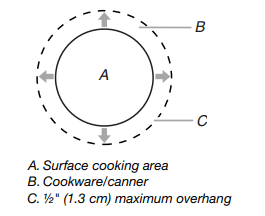
- Use flat-bottomed cookware for best heat conduction and energy efficiency. Cookware with rounded, warped, ribbed or dented bottoms could cause uneven heating and poor cooking results.
- Determine flatness by placing the straight edge of a ruler across the bottom of the cookware. While you rotate the ruler, no space or light should be visible between it and the cookware.
- Cookware designed with slightly indented bottoms or small expansion channels can be used.
- Make sure the bottoms of pots and pans are clean and dry before using them. Residue and water can leave deposits when heated.
- To avoid damage to the cooktop, do not cook foods directly on the cooktop.
Ceramic Glass Cooktop Cleaning
- Clean the cooktop after each use to help avoid scratches, pitting, abrasions and to condition the glass surface. Ceramic glass cooktop cleaner and a cooktop scraper are also recommended for stubborn soils. Do not use abrasive cleaners, cleaning pads or harsh chemicals for cleaning. The Cooktop Care Kit Part Number 31605 contains all of the items needed to clean and condition your ceramic glass cooktop. Refer to the “Range Care” section for additional information.
- IMPORTANT: To avoid permanent damage to the cooktop surface and to make soils easier to remove, clean the cooktop after each use to remove all soils.
Cooktop On Indicator Light
- The Cooktop On indicator light is located on the console panel. When any control knob on the console panel is turned on, the Cooktop On indicator light will glow.
Hot Surface Indicator
- Light On ceramic glass models, the hot surface indicator light is located on the console panel. The hot surface indicator light will glow as long as any surface cooking area is too hot to touch, even after the surface cooking area is turned off.
Dual Zone Cooking Element
- The Dual Zone Cooking Element offers flexibility depending on the size of the cookware. Single size can be used in the same way as a regular element. The dual size combines both the single and outer element and is recommended for larger size cookware.
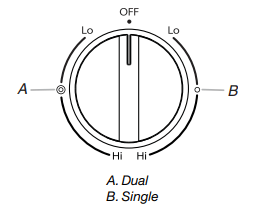
Warm Zone Element
- Use the Warm Zone element to keep cooked foods warm. One hour is the recommended maximum time to maintain food quality.
- Do not use it to heat cold foods.
- The Warm Zone element can be used alone or when any of the other surface cooking areas are being used.
- The Warm Zone element area will not glow red when cycling on. However, the Element On light will glow while the Cooktop Warm Zone element is in use.
- Use only cookware recommended for oven and cooktop use.
- Cover all foods with a lid or aluminum foil. When warming baked goods, allow a small opening in the cover for moisture to escape.
- To avoid damage to the cooktop, do not use plastic wrap to cover food because the plastic wrap may melt.
- Use pot holders or oven mitts to remove food.

To Use:
- To turn on, press WARM ZONE ON.
- To turn off, press WARM ZONE OFF.
Cookware
- IMPORTANT: Do not leave empty cookware on a hot surface cooking area, element or surface burner.
- Ideal cookware should have a flat bottom, straight sides and a wellfitting lid, and the material should be of medium-to-heavy thickness.
- Rough finishes may scratch the cooktop. Aluminum and copper may be used as a core or base in cookware. However, when used as a base they can leave permanent marks on the surfaces.
- Cookware material is a factor in how quickly and evenly heat is transferred, which affects cooking results. A nonstick finish has the same characteristics as its base material. For example, aluminum cookware with a nonstick finish will take on the properties of aluminum.
- Cookware with nonstick surfaces should not be used under the broiler.
- Check for flatness by placing the straight edge of a ruler across the bottom of the cookware. While you rotate the ruler, no space or light should be visible between it and the cookware.
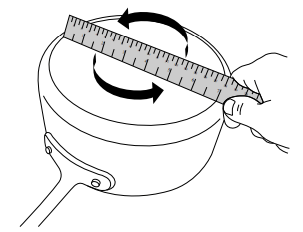
Use the following chart as a guide for cookware material characteristics.
| COOKWARE | CHARACTERISTICS |
| Aluminum |
|
| Cast iron |
|
| Ceramic or Ceramic glass |
|
| Copper |
|
| Earthenware |
|
| Porcelain enamel-onsteel or cast iron |
|
| Stainless steel |
|
Use flat-bottomed cookware for best cooking results and energy efficiency. The cookware should be about the same size as the cooking area outlined on the cooktop. Cookware should not extend more than ½" (13 mm) outside the area.
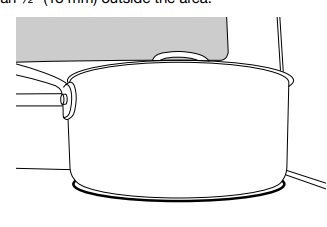
Home Canning
Canning can be performed on a glass smooth top cooking surface or traditional coil element cooktop. When canning for long periods, alternate the use of surface cooking areas or elements between batches. This allows time for the most recently used areas to cool.
- Center the canner on the largest surface cooking area or element. On electric cooktops, canners should not extend more than ½" (13 mm) beyond the surface cooking area or element.
- Do not place canner on 2 surface cooking areas or elements at the same time.
- On ceramic glass models, use only flat-bottomed canners to avoid damage to the cooktop and elements.
- For more information, contact your local agricultural extension office, or refer to published home canning guides. Companies that manufacture home canning products can also offer assistance.
OVEN USE
Odors and smoke are normal when the oven is used the first few times, or when it is heavily soiled.
IMPORTANT: The health of some birds is extremely sensitive to the fumes given off. Exposure to the fumes may result in death to certain birds. Always move birds to another closed and wellventilated room.
Electronic Oven Controls
Control Display
- The display will flash when powered up or after a power loss. Press CANCEL to clear. When oven is not in use, the time of day is displayed, unless the range is in Energy Save mode. During Energy Save mode, the display will be blank. Indicator lights show functions that are in use.
Options Mode
- Press and hold TIMER for 5 seconds, and “Opt” will appear. Use the Temp/Time “up” or “down” arrow pads to cycle through the following options. Press CANCEL to exit the mode.
- Fahrenheit and Celsius: The temperature is preset at Fahrenheit, but can be changed to Celsius. Press TIMER to toggle between Fahrenheit and Celsius. Press CANCEL to exit.
- End of Cycle: Tones “b1” (beep once) or “b” (continue to beep) will be displayed. Press TIMER to toggle through selections. Press CANCEL to exit.
- Oven Light with Door Open: “LOn” indicates that the oven light will turn on when the door is open. If “LOFF” is displayed, the oven light will turn on only with the oven light switch. Press TIMER to toggle through selection. Press CANCEL to exit.
- 12-Hour Shutoff: If “12 Hr” is displayed, the oven will automatically shut off after 12 hours. Press TIMER to toggle to “- - Hr” to disable the 12-hour shutoff. Press CANCEL to exit.
Tones: Tones are audible signals, indicating the following:
- Basic Functions
- One tone
- Valid pad press
- Oven is preheated (long tone)
- Function has been entered
- Reminder (on some models), repeating every 20 seconds after the end-of-cycle tones
- Three tones
- Invalid pad press
- Four tones
- End of cycle
- One tone
Energy Save
- The Energy Save feature places the control and clock into a Sleep mode that reduces power consumption when the range is not being used.
- To enter the Energy Save mode, the oven and control must be idle with the Time of Day (TOD) shown on the display. Press and hold CLOCK for 10 seconds. The control will beep and the display will show the letters “ES” followed by “On” twice. The display will return to the TOD. If Energy Save mode is activated, each time the range is idle for 5 minutes with only the Time of Day (TOD) shown, the display will show the letters “ES” followed by “On” twice.
- The display will then be blank until a control key is pressed or the oven door is opened. The control will then perform any of its operations in response to additional key presses.
- To exit Energy Save mode, press and hold the CLOCK key for 10 seconds. The control will beep and the display will show the letters “ES” followed by “Off” twice. The display will return to the TOD.
Oven Temperature Control
- IMPORTANT: Do not use a thermometer to measure oven temperature. Elements will cycle on and off as needed to provide consistent temperature but may run slightly hot or cool at any point in time due to this cycling. Most thermometers are slow to react to temperature change and will not provide an accurate reading due to this cycling.
- The oven provides accurate temperatures; however, it may cook faster or slower than your previous oven, so the temperature can be adjusted to personalize it for your cooking needs. It can be changed in Fahrenheit or Celsius.
- To Adjust Oven Temperature:
- Press and hold BAKE for 5 seconds until the oven display shows the current setting, for example “0°F CAL” or “00.”
- Press the Temp/Time “up” or “down” arrow pads to increase or to decrease the temperature in 10°F (5°C or 6°C) amounts. The adjustment can be set between 30°F (17°C) and -30°F (-17°C).
- Press START.
Sabbath Mode
- The Sabbath Mode sets the oven to remain on in a Bake setting until turned off. A Timed Bake can also be set to keep the oven on for only part of the Sabbath. The Oven Control Lockout Feature (if present) will be disabled during the Sabbath Mode. After the Sabbath Mode is set no tones will sound, the display will not show the temperature, the Kitchen Timer Mode will be canceled (if active) and only the following pads will function:
- “up” or “down” arrow pads
- Cancel
- When the oven door is opened or closed, the oven light will not turn on or off and the heating elements will not turn on or off immediately.
- When power is restored after a power failure, the oven will return to Sabbath Mode and remain Sabbath compliant with the bake elements off until the Cancel keypad is pressed.
- Pressing the Cancel keypad at any time returns the oven to the normal cooking mode (not Sabbath Mode compliant).
- Before entering the Sabbath Mode, it must be decided if the oven light is to be on or off for the entire Sabbath Mode period. If the light is on when entering Sabbath Mode, it will remain on for the entire time Sabbath Mode is in use. If the light is off when entering Sabbath Mode, it will remain off for the entire time Sabbath Mode is in use. Opening the oven door or pressing the Oven Light keypad will not affect the oven light once Sabbath Mode has been entered.
- If the oven has the Convection Bake feature, the oven light is controlled by a separate Oven Light switch on the console. If the oven light is on when entering the Sabbath Mode, it will remain on for the entire time Sabbath Mode is in use. For the oven light to be off during the Sabbath Mode, the light bulb must be removed from the oven prior to entering the Sabbath Mode. Not performing these steps will cause the oven light to turn on when the oven door is opened, resulting in the oven being not Sabbath compliant. On the Holiday, the oven temperature can be changed once the oven is in Sabbath Mode by pressing the “up” or “down” arrow pads. The oven temperature will change 25°F (14°C) each time the keypad is pressed. The display will not change, and there will be no sounds during this adjustment.
To Bake Using Sabbath Mode:
- Press BAKE.
- Press the “up” or “down” arrow pads.
- Press START.
- Press and hold the TIMER keypad for 5 seconds. “SAb” will flash in the display.
- Press START within 5 seconds to enter Sabbath Mode; otherwise, the entire cycle cancels out. “SAb” will stop flashing and remain on in the display. The oven is now in Sabbath Mode and is Sabbath compliant.
Pressing the Cancel keypad at any time returns the oven to the normal cooking mode (not Sabbath Mode compliant).
To set a Timed Bake using Sabbath Mode (on some models):
- Press BAKE.
- Press the “up” or “down” arrow pads to enter a temperature other than the one displayed.
- Press COOK TIME. The Cook Time oven indicator light will light up.
- Press the “up” or “down” arrow pads to enter a cook time length.
- Press START.
- Press and hold the TIMER keypad for 5 seconds. “SAb” will flash in the display.
- Press START within 5 seconds to enter Sabbath Mode; otherwise, the entire cycle cancels out. “SAb” will stop flashing and remain on in the display. The oven is now in Sabbath Mode and is Sabbath compliant. The Bake, On and Cook Time indicator lights will be displayed.
When the set cook time ends, the oven will shut off automatically and the indicator lights will turn off, indicating the end of the cycle.
Pressing the Cancel keypad at any time returns the oven to the normal cooking mode (not Sabbath Mode compliant).
To set a Delayed Timed Bake using Sabbath Mode (on some models):
- Press BAKE.
- Press the “up” or “down” arrow pads to enter a temperature other than the one displayed.
- Press COOK TIME. The Cook Time oven indicator light will light up.
- Press the “up” or “down” arrow pads to enter a cook time length.
- Press START TIME. The Start Time indicator light will light up.
- Press the “up” or “down” arrow pads to enter a start time.
- Press START.
- Press and hold the TIMER keypad for 5 seconds. “SAb” will flash in the display.
- Press START within 5 seconds to enter Sabbath Mode; otherwise, the entire cycle cancels out. “SAb” will stop flashing and remain on in the display. The oven is now in Sabbath Mode and is Sabbath compliant. The On and Delay indicator lights will be displayed.
When the start time is reached the Bake, On and Cook Time indicator lights will automatically turn on. When the set cook time ends, the oven will shut off automatically and the indicator lights will turn off, indicating the end of the cycle.
Pressing the Cancel keypad at any time returns the oven to the normal cooking mode (not Sabbath Mode compliant).
Aluminum Foil
- IMPORTANT: To avoid permanent damage to the oven bottom finish, do not line the oven bottom with any type of foil or liner.
- For best cooking results, do not cover entire oven rack with foil because air must be able to move freely
Positioning Racks and Bakeware
MPORTANT: To avoid permanent damage to the porcelain finish, do not place food or bakeware directly on the oven door or bottom.
Bakeware: To cook food evenly, hot air must be able to circulate. Allow 2" (5 cm) of space around bakeware and oven walls. Make sure that no bakeware piece is directly over another.
Racks
- Position racks before turning on the oven.
- Do not move racks with bakeware on them.
- Make sure racks are level.
To move a rack, pull it out to the stop position, raise the front edge, and then lift out. Use the following illustration and charts as a guide.
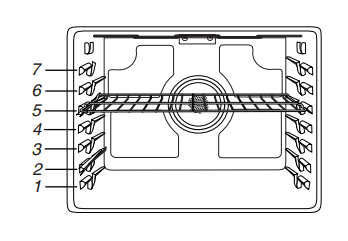
The oven has 7 positions for a flat rack, as shown in the previous illustration and the following table.
| Flat Rack Position* | Type of Food |
| 7 | Broiling/searing meats, hamburgers, steaks |
| 6 | Broiled meats, poultry, fish |
| 3 or 4 | Most baked goods, casseroles |
| 2 | Roasted meats |
| 1 | Large roasts or poultry |
- For hamburger patties to have a well-seared exterior and a rare interior, use rack position 7. Side 1 should cook for approximately 2½ - 3½ minutes. Side 2 should cook for approximately 4- 5 minutes. Expect a moderate degree of smoke when broiling.
- *If your model has a Max Capacity Oven Rack, the recessed ends must be placed in the rack position above the desired position of the food. See the following illustration.
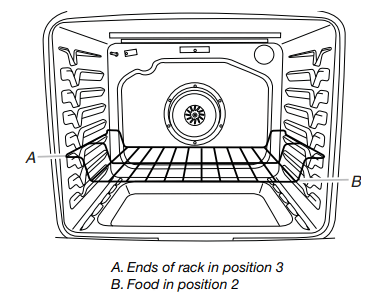
IMPORTANT: These rack positions are for flat racks. If a Max Capacity Oven Rack is used, the rack position must be adjusted as shown in the previous figure.
Multiple Rack Cooking 2-rack (non-convection):
- Use rack positions 2 and 5. 2-rack (convection):
- Use rack positions 2 and 5.
Baking Cookies and Layer Cakes on 2 Racks
- Baking Layer Cakes: For best results when baking cakes on 2 racks, use the Bake function and racks 2 and 5. Place the cakes on the racks as shown.
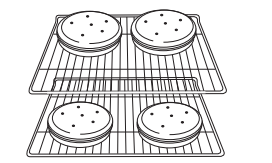
- Baking Cookies: For best results when baking cookies on 2 racks, use the Bake function and rack positions 2 and 5.
Oven Vent
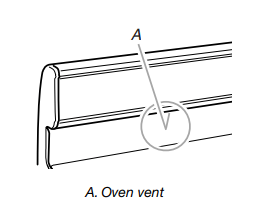
- The oven vent releases hot air and moisture from the oven, and should not be blocked or covered. Blocking or covering the vent will cause poor air circulation, affecting cooking and cleaning results. Do not set plastics, paper or other items that could melt or burn near the oven vent.
Baking and Roasting
- ACCUBAKE® Temperature Management System
- The ACCUBAKE® system electronically regulates the oven heat levels during preheat and bake to maintain a precise temperature range for optimal cooking results. The bake and broil elements cycle on and off in intervals. The bake element will glow red when cycling on; the broil element will not. This feature is automatically activated when the oven is in use.
- Before baking and roasting, position racks according to “Positioning Racks and Bakeware” section. When roasting, it is not necessary to wait for the oven preheat cycle to end before putting food in unless it is recommended in the recipe.
- Preheating
- When START is pressed, the oven will begin preheating. Once 100ºF (38ºC) is reached, the display temperature will increase as the actual temperature of the oven increases. When the preheat temperature is reached, a tone will sound, and the selected temperature will appear on the display.
- The time to preheat the oven to 350°F (175°C) will be approximately 10-15 minutes depending upon the model.
Broiling
- Leave the door open 4" (10.2 cm) at the broil stop position to ensure proper broiling temperature. Preheat the oven for 5 minutes before putting food in unless recommended otherwise in the recipe. Position food on grid in a broiler pan, then place it in the center of the oven rack.

- NOTE: Odors and smoke are normal the first few times the oven is used or if the oven is heavily soiled.
- Changing the temperature when broiling allows more precise control when cooking. The lower the broil setting, the slower the cooking. Thicker cuts and unevenly shaped pieces of meat, fish and poultry may cook better at lower broil settings. Use racks 6 or 7 for broiling. Refer to the “Positioning Racks and Bakeware” section for more information.
- On lower settings, the broil element will cycle on and off to maintain the proper temperature.
- For best results, use a broiler pan and grid. It is designed to drain juices and help avoid spatter and smoke. If you would like to purchase a broiler pan, one may be ordered. Please refer to the “Accessories” section for more information.
Convection Baking and Roasting (on some models)
- In a convection oven, the fan-circulated hot air continually distributes heat more evenly than the natural movement of air in a standard thermal oven. This movement of hot air helps maintain a consistent temperature throughout the oven, cooking foods more evenly, crisping surfaces while sealing in moisture and yielding crustier breads.
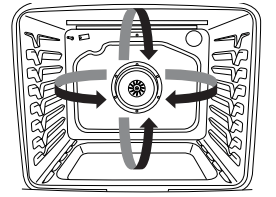
- With convection cooking, most foods can be cooked at a temperature 25°F (15°C) lower than in a standard thermal oven, and cooking time can be shortened by up to 30%.
- During convection baking or roasting, the bake and broil elements cycle on and off in intervals to maintain the oven temperature, while the fan circulates the hot air.
- If the oven door is opened during convection baking or roasting, the fan will turn off immediately. It will come back on when the oven door is closed.
Cook Time (on some models)
To Set a Timed Cook:
- Press BAKE. The bake indicator light will light up.
- Press the TEMP/TIME “up” or “down” arrow pads to enter a temperature other than the one displayed.
- Press COOK TIME. The cook time oven indicator light will light up.
- Press the TEMP/TIME “up” or “down” arrow pads to enter the length of time to cook.
- Press START. The display will count down the time. When the time ends, the oven will shut off automatically and “End” will appear on the display.
- Press CANCEL to clear the display.
To Set a Delayed Timed Cook: Before setting, make sure the clock is set to the correct time of day. See the “Clock” keypad feature in the “Feature Guide” section.
- Press BAKE.
- Press the TEMP/TIME “up” or “down” arrow pads to enter a temperature other than the one displayed.
- Press COOK TIME. The cook time oven indicator light will light up.
- Press TEMP/TIME “up” or “down” arrow pads to enter the length of time to cook.
- Press START TIME. The start time/delay oven indicator light will light up.
- Press TEMP/TIME “up” or “down” arrow pads to enter the time of day to start.
- Press START. When the start time is reached, the oven will automatically turn on. The temperature and/or time settings can be changed anytime after pressing Start by repeating steps 1-7. When the set cook time ends, the oven will shut off automatically and “End” will appear on the display.
- Press CANCEL to clear the display.
RANGE CARE
Clean Cycle

- AquaLift® Technology is an innovative cleaning solution that utilizes heat and water to release baked-on spills from the oven in less than 1 hour. This new cleaning technology is a low-heat, odor-free alternative to traditional self-cleaning options.
- Allow the oven to cool to room temperature before using the Clean cycle. If your oven cavity is above 200°F (93°C), “HOT” will appear in the display, and the Clean cycle will not be activated until the oven cavity cools down.
To Clean:
1. Remove all racks and accessories from the oven cavity and wipe excess soil. Use a plastic scraper to remove easilyremoved soils
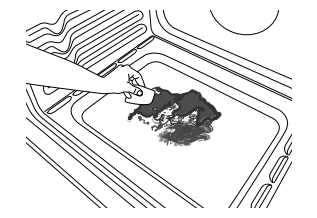
2. Pour 2 cups (16 oz [500 mL]) of distilled or filtered water onto the bottom of the empty oven and close the oven door.
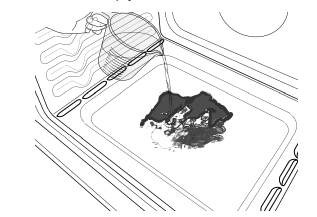
IMPORTANT: Do not use chemicals or other additives with the water. Do not open the oven door during the Clean cycle. The water on the oven bottom is hot.
3. Press AQUALIFT SELF CLEAN and then START on the oven control panel.
4. Allow 40 minutes for cleaning and cool down. A beep will sound when the Clean cycle is complete.
5. Press CANCEL at the end of the cycle. CANCEL may be pressed at any time to stop the Clean cycle.
6. Remove the residual water and loosened soils with a sponge or cloth immediately after the Clean cycle is complete. Much of the initial 2 cups (16 oz [500 mL]) of water will remain in the oven after the cycle is completed. If additional soils remain, leave a small amount of water in the oven bottom to assist with the cleaning.
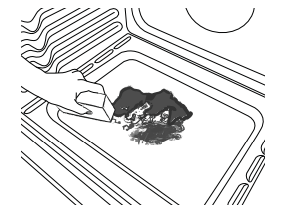
7. If any soils remain, remove them with a non-scratch scrubbing sponge or plastic scraper. Additional Clean cycles may be run to help remove the stubborn soils. IMPORTANT: Do not use oven cleaners. The use of chemicals, including commercial oven cleaners or metal scouring pads, may cause permanent damage to the porcelain surface of the oven interior.
NOTES:
- The range should be level to ensure that the entire surface of the bottom of the oven cavity is covered by water at the beginning of the Clean cycle.
- For best results, use distilled or filtered water. Tap water may leave mineral deposits on the oven bottom.
- Before removing the residual water and loosened soils at the end of the Clean cycle, insert a cloth or paper towel between the lower edge of the oven door and the front frame to keep water from spilling onto the front of the range and the floor.
- Soil baked on through several cooking cycles will be more difficult to remove with the Clean cycle.
- Nonabrasive scrub sponges or eraser style cleaning pads (without cleaners) can be effective for cleaning the oven cavity walls, oven door and oven bottom for difficult soils. For best results, moisten the pads and sponges before use.
- Run an additional Clean cycle for stubborn soils.
- affresh® Kitchen Appliance Cleaner and affresh® Cooktop Cleaner may be used to clean the oven bottom, walls and door when the oven has finished the cycle and returned to room temperature. If affresh® Cooktop Cleaner is used, it is recommended to wipe out the cavity with distilled water as well. Refer to the “Accessories” section for information on ordering.
- Additional AquaLift® Technology Cleaning Kits may be obtained by ordering Part Number W10423113RP. See the “Accessories” section for more information.
- For assistance with AquaLift® Technology, call 1-877-258-0808, or visit our website at whr.pl/aqualift.
General Cleaning
- IMPORTANT: Before cleaning, make sure all controls are off and the oven and cooktop are cool. Always follow label instructions on cleaning products. For additional information, you can visit the Frequently Asked Questions (FAQs) section at whirlpool.com.
- Soap, water and a soft cloth or sponge are suggested first unless otherwise noted.
EXTERIOR PORCELAIN ENAMEL SURFACES (on some models)
- Food spills containing acids, such as vinegar and tomato, should be cleaned as soon as the entire range is cool. These spills may affect the finish.
- Cleaning Method:
- Glass cleaner, mild liquid cleaner or nonabrasive scrubbing pad: Gently clean around the model and serial number plate because scrubbing may remove numbers.
- affresh® Kitchen and Appliance Cleaner Part Number W10355010 (not included): See the “Accessories” section for more information.
STAINLESS STEEL (on some models)
- NOTE: To avoid damage to stainless steel surfaces, do not use soap-filled scouring pads, abrasive cleaners, Cooktop Cleaner, steel-wool pads, gritty washcloths or abrasive paper towels. Damage may occur to stainless steel surfaces, even with one-time or limited use.
- Cleaning Method: Rub in direction of grain to avoid damaging.
- affresh® Stainless Steel Cleaner Part Number W10355016: See the “Accessories” section for more information.
- Liquid detergent or all-purpose cleaner: Rinse with clean water and dry with soft, lint-free cloth
METALLIC PAINT (on some models)
- Do not use abrasive cleaners, cleaners with bleach, rust removers, ammonia or sodium hydroxide (lye) because paint surface may stain.
CERAMIC GLASS (on some models)
- Cleaning Method:
- Use affresh® Cooktop Cleaner Part Number W10355051, Cooktop Cleaning Pads Part Number W10391473 and Cooktop Scraper Part Number WA906B to clean and remove stains from the cooktop. Use Cooktop Protectant Part Number 31463A regularly to avoid stain buildup, pitting and scratching, while conditioning the cooktop for easier future cleaning. These can be ordered as accessories. See the “Accessories” section for more information. The Cooktop Scraper uses razor blades. Store razor blades out of the reach of children.
- Do not use steel wool, abrasive powder cleansers, chlorine bleach, rust remover or ammonia because damage may occur.
- Light to moderate soil
- Can be cleaned with damp paper towels or sponge. Light stains should be addressed with cleaner and cleaning pad.
- Sugary spills (jellies, candy, syrup)
- Cooktop Scraper: Scrape off sugary spills while the cooktop is still warm. You may want to wear oven mitts while cleaning the cooktop.
- affresh® Cooktop Cleaner and Cooktop Cleaning Pads: Clean as soon as cooktop has cooled down. Rub product into surface with a Cooktop Cleaning Pad. Continue rubbing until white film disappears.
- Heavy soil, dark streaks, specks and discoloration
- Clean with Cooktop Cleaner or nonabrasive cleaner and cleaning pad.
- Burned-on soil
- affresh® Cooktop Cleaner or nonabrasive cleanser with Cooktop Cleaning Pads: Clean as soon as cooktop has cooled down. Rub product into soil with a Cooktop Cleaning Pad. Continue rubbing until white film disappears.
- Metal marks from aluminum and copper
- affresh® Cooktop Cleaner and Cooktop Cleaning Pads: Clean as soon as cooktop has cooled down. Rub product into surface with a Cooktop Cleaning Pad. Continue rubbing until white film disappears. The marks will not totally disappear, but after many cleanings they will become less noticeable.
- Tiny scratches and abrasions
- affresh® Cooktop Cleaner and Cooktop Cleaning Pads: Clean as soon as cooktop has cooled down. Rub product into surface with a Cooktop Cleaning Pad. Continue rubbing until white film disappears. Scratches and abrasions do not affect cooking performance, and after many cleanings they will become less noticeable.
COOKTOP CONTROLS
- To avoid damage to the cooktop controls, do not use steel wool, abrasive cleansers or oven cleaner.
- To avoid damage, do not soak knobs. When replacing knobs, make sure knobs are in the Off position.
- On some models, do not remove seals under knobs.
- Cleaning Method:
- Soap and water: Pull knobs straight away from control panel to remove.
CONTROL PANEL AND OVEN DOOR EXTERIOR
- To avoid damage to the control panel, do not use abrasive cleaners, steel-wool pads, gritty washcloths or abrasive paper towels.
- Cleaning Method:
- Glass cleaner and soft cloth or sponge: Apply glass cleaner to soft cloth or sponge, not directly on panel.
- affresh® Kitchen and Appliance Cleaner Part Number W10355010 (not included): See the “Accessories” section for more information.
OVEN RACKS
- Cleaning Method:
- Steel-wool pad
- For racks that have discolored and are harder to slide, a light coating of vegetable oil applied to the rack guides will help them slide.
STORAGE DRAWER OR WARMING DRAWER (on some models)
- Check that storage drawer or warming drawer is cool and empty before cleaning.
- Cleaning Method:
- Mild detergent
OVEN CAVITY
- Use AquaLift® Technology regularly to clean oven spills.
- Do not use oven cleaners.
- Food spills should be cleaned when oven cools. At high temperatures, foods react with porcelain and staining, etching, pitting or faint white spots can result.
- Cleaning Method:
- Clean cycle: See “Clean Cycle” first.
Oven Light
The oven light is a standard 40-watt appliance bulb. Before replacing, make sure the oven and cooktop are cool and the control knobs are in the off position.
To Replace:
- Unplug range or disconnect power.
- Turn the glass bulb cover in the back of the oven counterclockwise to remove.
- Turn bulb counterclockwise to remove from socket.
- Replace bulb, then bulb cover by turning clockwise.
- Plug in range or reconnect power.
TROUBLESHOOTING
Operation
| PROBLEM | POSSIBLE CAUSES | SOLUTIONS |
| Nothing will operate |
Power supply cord is unplugged ENERGY SAVE is active, and the display is blank. Household fuse is blown, or a circuit breaker is tripped. The control displays an F9 or F9 E0 error code. |
Plug into a grounded outlet. Press any key on the control to display the Time of Day. See the “Electronic Oven Controls” section for more information. Replace the fuse or reset the circuit breaker. If the problem continues, call an electrician. The electrical outlet in the home may be miswired. Contact a qualified electrician to verify the electrical supply. |
| Cooktop will not operate |
The control knob is not set correctly On ceramic glass models, the oven control lockout is set. |
Push in knob before turning to a setting. See the control lock keypad feature in the “Feature Guide.” |
| Excessive heat around cookware on cooktop | Cookware is not the proper size | Use cookware about the same size as the surface cooking area, element or surface burner. Cookware should not extend more than ¹⁄₂" (1.3 cm) outside the cooking area. |
| Cooktop cooking results not what expected |
Control knob set to incorrect heat level. Range is not level. |
See “Cooktop Use” section. Level the range. See the Installation Instructions. |
| Cooktop element cycles on and off on High setting | Element cycling due to a temperature limiter | This is normal operation. The element may cycle on and off to keep the cooktop from overheating |
| Oven will not operate |
Delay start is set. Control lock is on Control is in Demo Mode. Electronic oven control set incorrectly |
See “Cook Time” section Press and hold START for 3 seconds to unlock. Press and hold START TIME for 10 seconds to exit Demo Mode. Demo Mode is used for display models in a showroom. See “Electronic Oven Controls” section. |
| Oven temperature too high or too low | Oven temperature needs adjustment. | See “Oven Temperature Control” in the “Electronic Oven Controls” section. |
| Oven indicator lights flash | Power to range is turned on or restored. | See “Control Display” in the “Electronic Oven Controls” section. If the indicator lights keep flashing, call for service. See cover for contact information |
| Display shows messages |
Power failure (display shows flashing time). Error code (display shows letter followed by number). Start needs to be pressed so a cycle can begin (display shows “PUSH” or “PSH”). |
Clear the display. On some models, reset the clock, if needed. See “Clock” keypad feature in the “Feature Guide” section. Depending on your model, press CANCEL to clear the display. See “Control Display” in the “Electronic Oven Controls” section. If it reappears, call for service. See cover for contact information. See the “Start” keypad feature in the “Feature Guide” section. |
| Clean cycle did not work on all spills | Several cooking cycles between Clean cycles or spills on oven walls and doors. | Run additional Clean cycles. Use the AquaLift® Technology Cleaning Kit. affresh® Kitchen and Appliance Cleaner or affresh® Cooktop Cleaner can be used for stubborn soils. See the “Accessories” section for more information. |
| Mineral deposits are left on the oven bottom after the Clean cycle |
Tap water was used in the Clean cycle Range is not level. |
Use distilled or filtered water in the Clean cycle. To remove deposits, use a cloth soaked with vinegar. Then use a cloth dampened with water to thoroughly remove any vinegar residue. Mineral deposits will collect on dry areas of the oven bottom during the Clean cycle. Level the range. See the Installation Instructions. To remove deposits, use a cloth soaked with vinegar. Then use a cloth dampened with water to thoroughly remove any vinegar residue. |
| Oven cooking results not what expected |
Range is not level. The temperature set was incorrect Oven temperature needs adjustment. Oven was not preheated. Racks were positioned improperly Not enough air circulation around bakeware. Batter distributed unevenly in pan. Darker browning of food caused by dull or dark bakeware. Lighter browning of food caused by shiny or light colored bakeware Incorrect length of cooking time was used. Oven door was not closed. Oven door was opened during cooking. Rack is too close to bake burner, making baked items too brown on bottom. Pie crusts browning too quickly |
Level the range. See the Installation Instructions Double-check the recipe in a reliable cookbook See “Oven Temperature Control” in the “Electronic Oven Controls” section. See “Baking and Roasting” section. See “Positioning Racks and Bakeware” section. See “Positioning Racks and Bakeware” section. Check that batter is level in the pan Lower oven temperature 25°F (15°C) or move rack to a higher position in the oven. Move rack to a lower position in the oven. Adjust cooking time. Be sure that the bakeware does not keep the door from closing Oven peeking releases oven heat and can result in longer cooking times. Move rack to higher position in the oven. Use aluminum foil to cover the edge of the crust and/or reduce baking temperature. |
See other models: WFE525S0JV WFE320M0JS ED2GTMXRQ WFG530S0EW ABB2527DEB
